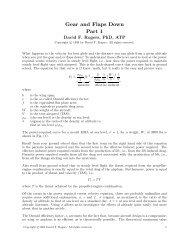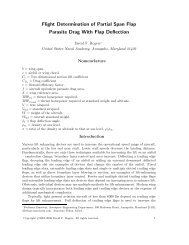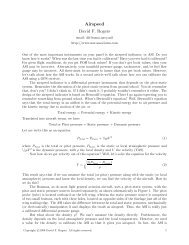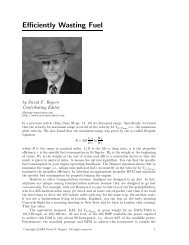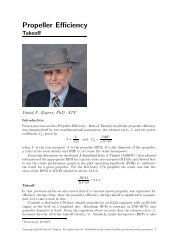Gear and Flaps Down Part 2 - NAR Associates
Gear and Flaps Down Part 2 - NAR Associates
Gear and Flaps Down Part 2 - NAR Associates
Create successful ePaper yourself
Turn your PDF publications into a flip-book with our unique Google optimized e-Paper software.
which shows that V RCmax (dirty)<br />
decreases by approximately 16% from the clean configuration.<br />
Lowering the gear <strong>and</strong> extending the flaps to 30 ◦ approximately triples the equivalent flat plate<br />
area, f. For this configuration<br />
V RCmax ( (dirty) 1 ) 1/4<br />
= =0.76<br />
V RCmax (clean)<br />
3<br />
which shows that V RCmax (dirty)<br />
decreases by approximately 24% from the clean configuration.<br />
These are significant effects. Notice that these are exactly the same factors by which the best glide<br />
velocity decreases when the gear <strong>and</strong>/or flaps are extended.<br />
What these results tell us is that with gear down <strong>and</strong> flaps extended the aircraft must be flown at<br />
the correct (lower) velocity to achieve the maximum rate-of-climb.<br />
We now want to investigate the effect of flying the aircraft at the incorrect velocity for the maximum<br />
rate-of-climb. To do this we need to more accurately consider the variation of propeller efficiency<br />
with velocity. For a typical McCauley 80 inch diameter constant-speed three blade propeller, the<br />
propeller efficiency, η, at full throttle <strong>and</strong> 2700 rpm at sea level is shown in Figure 2. Notice that<br />
the efficiency is quite low at low velocities <strong>and</strong> reaches a maximum of about 88-90% for typical<br />
cruise velocities. The effect of the variation of propeller efficiency with velocity on the curve of<br />
thrust power available is shown as the dotted line in Fig. (3).<br />
Recalling the rate-of-climb equation shows that taking the difference between the thrust power<br />
available curve <strong>and</strong> the power required curves at a given velocity <strong>and</strong> dividing by the weight yields<br />
the rate-of-climb at that velocity.<br />
The rate-of-climb curves for the clean configuration (labelled f <strong>and</strong> shown solid), gear down or.<br />
flaps extended (labelled 2f <strong>and</strong> shown dashed) <strong>and</strong> gear <strong>and</strong> flaps down (labelled 3f <strong>and</strong> shown<br />
dotted) are given in Fig. (4). Zero rate-of-climb is indicated by the horizontal dotted line. Because<br />
of the variation of propeller efficiency with velocity the velocity for maximum rate-of-climb is higher<br />
than given by our earlier approximate results.<br />
For example, with gear down <strong>and</strong> flaps extended our results indicate that maximum rate-of-climb<br />
is approximately 810 fpm at approximately 89 mph. However, the POH (old version) gives the<br />
velocity for best rate-of-climb gear <strong>and</strong> flaps down as 77 mph. Our results appear to be about<br />
13% too high. The explanation is that our rate-of-climb equation does not account for the upward<br />
inclination of the thrust produced by the propeller nor for the effect of the propeller slip stream<br />
on the wing. The detailed analysis is too complex to go into here, but we can estimate the effects<br />
of propeller thrust indirectly. For an E33A the POH (old version) gives the gross weight stalling<br />
velocity gear <strong>and</strong> flaps down power off as 61 mph <strong>and</strong> power on as 46 mph.<br />
The corresponding values for gear <strong>and</strong> flaps up are 72 mph <strong>and</strong> 57 mph. Thus, the effect of power is<br />
to reduce the stalling velocity 20-25%. Because the velocities for maximum rate-of-climb are higher<br />
than the stall velocities, the effect of power is decreased by about 50%. Using a 13% reduction in<br />
the calculated velocity for maximum rate-of-climb yields the value given in the POH. Incidentally<br />
77 mph is the experimental value for 4000 feet published by Taylor <strong>and</strong> Guinther in Positive Flying,<br />
+ a book that I recommend.<br />
What is most important from all this discussion is to note that flying at either too slow or too<br />
high a velocity degrades the climb performance. Also, note that maximum rate-of-climb occurs<br />
+ Richard L. Taylor <strong>and</strong> William M. Guinther, Positive Flying, MacMillan, New York, 1978.<br />
Copyright c○1996 David F. Rogers. All rights reserved. 4



